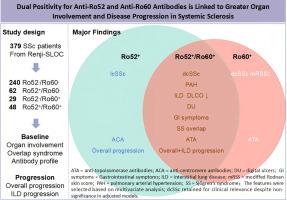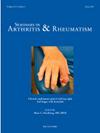抗ro52和抗ro60抗体双重阳性与系统性硬化症中更大的器官受累和疾病进展有关
IF 4.4
2区 医学
Q1 RHEUMATOLOGY
引用次数: 0
摘要
目的探讨抗ro52 /TRIM21抗体和抗ro60 /SSA抗体对系统性硬化症(SSc)患者临床特征及预后的单独及联合影响。方法采用来自仁济硬皮病纵向队列(Renji- sloc)的单中心观察性研究,包括379例SSc患者,随访至少1年。根据患者血清学状态分为4组:双阴性(Ro52−/Ro60−)、分离抗Ro52/TRIM21阳性(Ro52+)、分离抗Ro60/SSA阳性(Ro60+)、双阳性(Ro52+/Ro60+)。采用多变量logistic回归和生存分析分析临床特征和疾病进展。结果379例患者中,双阳性48例(12.7%)。值得注意的是,43.6%的ro52阳性患者同时出现ro60阳性,62.3%的ro60阳性患者同时出现ro52阳性,具有显著的共发性。双阳性患者的ILD(79.2%)、PAH(25.0%)、数字溃疡(41.7%)和胃肠道症状(79.2%)的发生率明显较高。多变量分析证实双阳性独立增加ILD(校正OR=2.27, 95% CI=1.02-5.14)、PAH(校正OR=2.24, 95% CI=1.03-4.84)、指部溃疡(校正OR=3.12, 95% CI=1.57-6.20)和胃肠道受累(校正OR=2.28, 95% CI=1.08-4.81)的风险。生存分析显示,双阳性患者的无进展生存期明显较差(总进展调整后HR=1.90, 95% CI=1.24-2.90;ILD进展的校正HR=2.20, 95% CI=1.36-3.57, p < 0.05)。结论抗ro52和抗ro60抗体双重阳性表明SSc亚群具有严重器官受累和疾病加速进展,尤其是ILD。这些发现强调了联合抗体检测的预后价值,并强调了对双阳性患者进行警惕监测的必要性。本文章由计算机程序翻译,如有差异,请以英文原文为准。

Dual positivity for Anti-Ro52 and Anti-Ro60 antibodies is linked to greater organ involvement and disease progression in systemic sclerosis
Objectives
To investigate the distinct and combined effects of anti-Ro52/TRIM21 and anti-Ro60/SSA antibodies on the clinical features and prognosis of patients with systemic sclerosis (SSc).
Methods
A single-center observational study was conducted using data from the Renji Scleroderma Longitudinal Cohort (Renji-SLOC), including 379 SSc patients with at least 1 year of follow-up. The patients were categorized into four groups based on serological status: double-negative (Ro52−/Ro60−), isolated anti-Ro52/TRIM21 positive (Ro52+), isolated anti-Ro60/SSA positive (Ro60+), double-positive (Ro52+/Ro60+). Clinical features and disease progression were analyzed using multivariable logistic regression and survival analysis.
Results
Among 379 patients, 12.7% (n=48) were double-positive. Notably, 43.6% of Ro52-positive patients were also Ro60-positive, and 62.3% of Ro60-positive patients were Ro52-positive, indicating significant co-occurrence. Double-positive patients exhibited significantly higher rates of ILD (79.2%), PAH (25.0%), digital ulcers (41.7%), and gastrointestinal symptoms (79.2%). Multivariable analysis confirmed that double positivity independently increased risks of ILD (adjusted OR=2.27, 95% CI=1.02-5.14), PAH (adjusted OR=2.24, 95% CI=1.03-4.84), digital ulcers (adjusted OR=3.12, 95% CI=1.57-6.20), and gastrointestinal involvement (adjusted OR=2.28, 95% CI=1.08-4.81). Survival analysis demonstrated significantly worse progression-free survival in double-positive patients (adjusted HR=1.90, 95% CI=1.24-2.90 for overall progression; adjusted HR=2.20, 95% CI=1.36-3.57 for ILD progression, both p<0.05).
Conclusion
Dual positivity for anti-Ro52 and anti-Ro60 antibodies identifies a distinct SSc subgroup with severe organ involvement and accelerated disease progression, particularly ILD. These findings highlight the prognostic value of combined antibody testing and underscore the need for vigilant monitoring in double-positive patients.
求助全文
通过发布文献求助,成功后即可免费获取论文全文。
去求助
来源期刊
CiteScore
9.20
自引率
4.00%
发文量
176
审稿时长
46 days
期刊介绍:
Seminars in Arthritis and Rheumatism provides access to the highest-quality clinical, therapeutic and translational research about arthritis, rheumatology and musculoskeletal disorders that affect the joints and connective tissue. Each bimonthly issue includes articles giving you the latest diagnostic criteria, consensus statements, systematic reviews and meta-analyses as well as clinical and translational research studies. Read this journal for the latest groundbreaking research and to gain insights from scientists and clinicians on the management and treatment of musculoskeletal and autoimmune rheumatologic diseases. The journal is of interest to rheumatologists, orthopedic surgeons, internal medicine physicians, immunologists and specialists in bone and mineral metabolism.

 求助内容:
求助内容: 应助结果提醒方式:
应助结果提醒方式:


